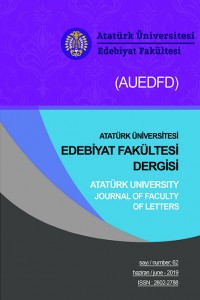Abstract
In this paper, the relationship between game and culture from antiquity to the present will be analysed. Culture-building, social change triggering, creative and entertaining features of the game will be discussed. The structure of the games is complicated by the development of societies. The game in ancient Rome is about the war since the child is considered a small adult. In ancient times, the child's game instruments are the items that their parents used to do their daily work. In ancient Greece, the game is in public spaces. In the modern era, the meaning of the game has expanded, and the world has been portrayed as a playground. In modern times, game is seen as the activity of leisure and is often the child's work. Nowadays, games have undergone a digital transformation, which is parallel to the digitalization of our daily lives. However, games have turned into ideology-laden consumption products as a product of cultural industry.
Keywords
References
- And, M. (2016). Oyun ve Bugu: Türk Kültüründe Oyun Kavramı. İstanbul: YKY. Bateson, P. ve Martin, P. (2014) Oyun, Oyunbazlık, Yaratıcılık ve İnovasyon. Songül Kırgezen (Çev.). İstanbul: Ayrıntı Yayınları. Bauman, Z. (2016/1). Postmodern Etik. Alev Türker (Çev.). İstanbul: Ayrıntı Yayınları. Bauman, Z. (2016/2). Modernite ve Holokaust. Süha Sertabiboğlu (Çev.). İstanbul: Alfa Yayınları. Binark, M. ve Bayraktutan-Sütçü, G. (2009). “Devasa Çevrimiçi Oyunlarda Türklüğün Oynanması: Silkroad Online’da Sanal Cemaat İnşası ve Türk Klan Kimliği.” M.Binark, G. Bayraktutan-Sütçü ve I.B. Fidaner, (Ed.). Dijital Oyun Rehberi: Oyun Tasarımı, Türler ve Oyuncu. (s.275-312). İstanbul: Kalkedon Yayınları. Binark, M. ve Bayraktutan-Sütçü, G. (2008). Kültür Endüstrisi Ürünü Olarak Dijital Oyun. İstanbul: Kalkedon Yayınları. Burns, B. (2015). Oyun Kitabı. T. Tunç Bilgin (Çev.). İstanbul: Kuzey Yayınları. Caillois, R. (2001). Man, Play and Games. Chicago: University of Illinois Press. Dursun, Y. (2014). Oyunun Ontolojisi. Ankara: Doğu Batı Yayınları ‘Game’. (2017). Online Etymology Dictionary, erişim 09.01.2017, 18:00 https://www.etymonline.com/word/game Gerbner, G. (1973). Communications Technology and Social policy: Understanding the New Cultural Revolution. NewYork: Interscience Publication. Gülsoy, S. (2017/1). Dijital Oyuncu Kimliğinin İnşası ve Sunumu. Yayımlanmamış doktora tezi. Atatürk Üniversitesi, Erzurum. Gülsoy, S. (2017/2). “Bir Uyarlama Denemesi: Dijital Oyunlarda Sahne”. Sosyoloji Divanı, Sayı: 9, s.149-164.
Abstract
Bu çalışmada antikiteden günümüze oyun ve kültür arasındaki ilişki incelenecektir. Oyunun kültür yapıcı, toplumsal değişmeyi tetikleyici, yaratıcı ve eğlendirici özellikleri üzerinde durulacaktı. Oyunların yapısı toplumların gelişimine paralel şekilde karmaşıklaşmaktadır. Antik Roma’da çocuk, küçük bir yetişkin kabul edildiği için oyun savaş ile ilgilidir. Antik dönemlerde çocuğun oyun aletleri ebeveynlerinin eskiden gündelik işlerini yaptıkları eşyalardır. Antik Yunan’da oyun kamusal alanların içerisindedir. Modern dönemde oyunun anlamı genişlemiş ve dünya oyun alanı olarak tasvir edilmeye başlanmıştır. Modern dönemde oyun, boş zaman aktivitesidir ve ekseriyetle çocuğun işidir. Günümüzde oyunlar dijital dönüşüm geçirmiştir ve bu da gündelik yaşamımızın dijitalleşen yapısıyla paralel bir değişimdir. Ancak oyunlar, günümüzde birer kültür endüstrisi ürünü olarak ideoloji yüklü tüketim ürünlerine dönüşmüştür.
References
- And, M. (2016). Oyun ve Bugu: Türk Kültüründe Oyun Kavramı. İstanbul: YKY. Bateson, P. ve Martin, P. (2014) Oyun, Oyunbazlık, Yaratıcılık ve İnovasyon. Songül Kırgezen (Çev.). İstanbul: Ayrıntı Yayınları. Bauman, Z. (2016/1). Postmodern Etik. Alev Türker (Çev.). İstanbul: Ayrıntı Yayınları. Bauman, Z. (2016/2). Modernite ve Holokaust. Süha Sertabiboğlu (Çev.). İstanbul: Alfa Yayınları. Binark, M. ve Bayraktutan-Sütçü, G. (2009). “Devasa Çevrimiçi Oyunlarda Türklüğün Oynanması: Silkroad Online’da Sanal Cemaat İnşası ve Türk Klan Kimliği.” M.Binark, G. Bayraktutan-Sütçü ve I.B. Fidaner, (Ed.). Dijital Oyun Rehberi: Oyun Tasarımı, Türler ve Oyuncu. (s.275-312). İstanbul: Kalkedon Yayınları. Binark, M. ve Bayraktutan-Sütçü, G. (2008). Kültür Endüstrisi Ürünü Olarak Dijital Oyun. İstanbul: Kalkedon Yayınları. Burns, B. (2015). Oyun Kitabı. T. Tunç Bilgin (Çev.). İstanbul: Kuzey Yayınları. Caillois, R. (2001). Man, Play and Games. Chicago: University of Illinois Press. Dursun, Y. (2014). Oyunun Ontolojisi. Ankara: Doğu Batı Yayınları ‘Game’. (2017). Online Etymology Dictionary, erişim 09.01.2017, 18:00 https://www.etymonline.com/word/game Gerbner, G. (1973). Communications Technology and Social policy: Understanding the New Cultural Revolution. NewYork: Interscience Publication. Gülsoy, S. (2017/1). Dijital Oyuncu Kimliğinin İnşası ve Sunumu. Yayımlanmamış doktora tezi. Atatürk Üniversitesi, Erzurum. Gülsoy, S. (2017/2). “Bir Uyarlama Denemesi: Dijital Oyunlarda Sahne”. Sosyoloji Divanı, Sayı: 9, s.149-164.
Details
| Primary Language | Turkish |
|---|---|
| Subjects | Creative Arts and Writing |
| Journal Section | Articles |
| Authors | |
| Publication Date | June 27, 2019 |
| Submission Date | May 14, 2019 |
| Published in Issue | Year 2019 Issue: 62 |


